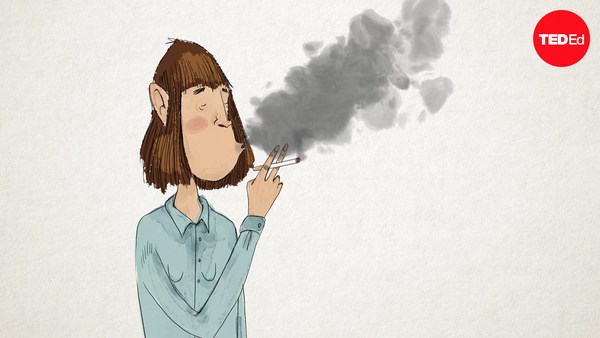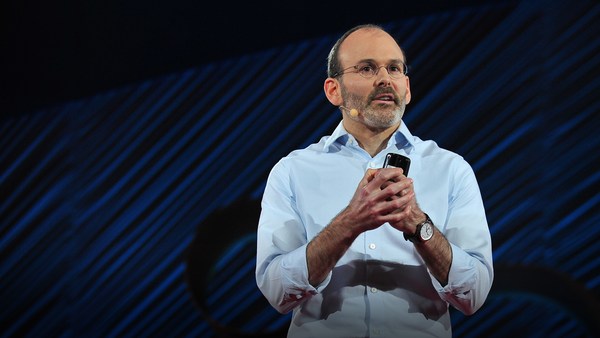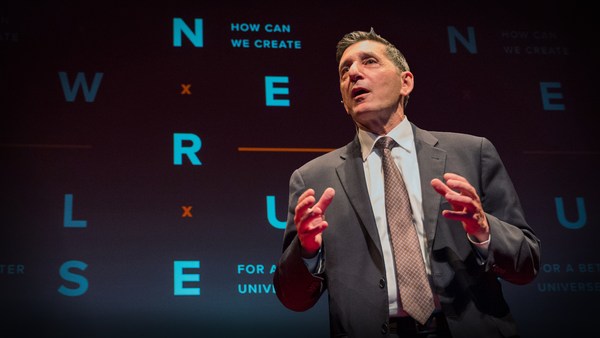I'm going to tell you a story. I'm going to tell you a story about how the deadliest consumer product imaginable came to be. It's the cigarette. The cigarette is the only consumer product that, when used as intended, will kill half of all long-term users prematurely, later in life. But this is also a story about the work that we're doing at the Food and Drug Administration, and specifically, the work that we're doing to create the cigarette of the future, that is no longer capable of creating or sustaining addiction.
A lot of people think that the tobacco problem or the smoking problem has been solved in the United States because of the great progress that's been made over the last 40, 50 years, when it comes to both consumption and prevalence. And it's true; smoking rates are at historic lows. It's true for both adults and for kids. And it's true that those who continue to smoke are smoking far fewer cigarettes per day than at any time in history.
But what if I told you that tobacco use, primarily because of firsthand and secondhand exposure to the smoke in cigarettes, remains the leading cause of completely preventable disease and death in this country? Well, that's true. And what if I told you that it's actually killing more people than we thought to be the case ever before? That's true, too. Smoking kills more people each year than alcohol, AIDS, car accidents, illegal drugs, murders and suicides combined. Year in and year out.
In 2014, Dr. Adams's predecessor released the 50th anniversary Surgeon General's report on smoking and health. And that report upped the annual death toll from smoking, because the list of smoking-related illnesses got bigger. And so it is now conservatively estimated that smoking kills 480,000 Americans every year. These are completely preventable deaths.
How do we wrap our heads around a statistic like this? So much of what we've heard at this conference is about individual experiences and personal experiences. How do we deal with this at a population level, when there are 480,000 moms, dads, sisters, brothers, aunts and uncles dying unnecessary deaths every year from tobacco?
And then what happens when you think about this trajectory for the future? And just do the simple math: from the time of the 50th anniversary Surgeon General's report five years ago, when this horrible statistic was raised, just through mid-century -- that's more than 17 million avoidable deaths in the United States from tobacco use, primarily because of cigarettes. The Surgeon General concluded that 5.6 million children alive in the United States in 2014 will die prematurely later in life because of cigarettes. Five point six million children.
So this is an enormous public health problem for all of us but especially for us as regulators at the Food and Drug Administration and the Center for Tobacco Products. What can we do about it? What can we do to reverse this trajectory of disease and death?
Well, we have an interesting guide to help unravel issues like: How did the cigarette as we know it come to be? What is the true nature of the tobacco and cigarette business? How did the industry behave in the historically unregulated marketplace? And our guide is previously secret internal documents from the tobacco industry. Come with me in a tobacco industry document time machine.
Nineteen sixty-three was 25 years before the Surgeon General was finally able to conclude that the nicotine and cigarettes was addictive. That did not happen until the Surgeon General's report in 1998. Nineteen sixty-three was one year before the first-ever Surgeon General's report in 1964.
I remember 1964. I don't remember the Surgeon General's report, but I remember 1964. I was a kid growing up in Brooklyn, New York. This was at a time when almost one in two adults in the United States smoked. Both of my parents were heavy smokers at the time. Tobacco use was so incredibly normalized that -- and this wasn't North Carolina, Virginia or Kentucky, this was Brooklyn -- we made ashtrays for our parents in arts and crafts class.
(Laughter)
The ashtrays I made were pretty awful, but they were ashtrays.
(Laughter)
So normalized that I remember seeing a bowl of loose cigarettes in the foyer of our house and other houses as a welcoming gesture when friends came over for a visit.
OK, we're back in 1963. The top lawyer for Brown and Williamson, which was then the third-largest cigarette company in the United States, wrote the following: "Nicotine is addictive. We are, then, in the business of selling nicotine -- an addictive drug." It's a remarkable statement, as much for what it doesn't say as for what it does say. He didn't say they were in the cigarette business. He didn't say they were in the tobacco business. He said they were in the business of selling nicotine.
Philip Morris in 1972: "The cigarette isn't a product, it's a package. The product is nicotine. The pack is a storage container for a day's supply of nicotine. The cigarette, a dispenser for a dose unit of nicotine." We'll come back to this dose unit notion later.
And R.J. Reynolds in 1972: "In a sense, the tobacco industry may be thought of as being a specialized, highly ritualized and stylized segment of the pharmaceutical industry. Tobacco products uniquely contain and deliver nicotine, a potent drug with a variety of physiological effects."
At the time, and for many decades, publicly, the industry completely denied addiction and completely denied causality. But they knew the true nature of their business. And from time to time, there have been health scares made public about cigarettes, going back many decades. How did the industry respond? And how did they respond in this historically unregulated marketplace?
Going back to the 1930s, it was with advertising that heavily featured imagery of doctors and other health care professionals sending messages of reassurance. This is an ad for Lucky Strikes, the popular cigarette of the time in the '30s:
[20,679 physicians say "Luckies are less irritating." Your throat protection against irritation, against cough.]
(Laughter)
We laugh, but this was the kind of advertising that was there to send a health message of reassurance.
Fast-forward to 1950s, '60s and '70s. And here, again, in the absence of regulation, what we're going to see is modifications to the product and product design to respond to the health concerns of the day.
This is the Kent Micronite filter. And here, the innovation, if you will, was the filtered cigarette.
[Full smoking pleasure ... plus proof of the greatest health protection ever.]
What the smoker of this product didn't know, what their doctor didn't know, what the government didn't know, is that this was a filter that was lined with asbestos --
(Gasps) so that when smokers were smoking this filtered cigarette and still inhaling the chemicals and smoke that we know are associated with cancer and lung disease and heart disease, they were also sucking down asbestos fibers. (Gasps)
In the 1960s and the 1970s, the so-called innovation was the light cigarette. This is a typical brand of the day called True. And this is after the Surgeon General's reports have started coming out. And you see the look of concern on her face.
[Considering all I'd heard, I decided to either quit or smoke True. I smoke True.]
(Laughter)
[The low tar, low nicotine cigarette.] And then it says, "Think about it." And then even below that in the small print are tar numbers and nicotine numbers. What was a light cigarette? How did it work?
This is an illustration of the product modification known as "filter ventilation." That's not a real filter blown up. That's just a picture so that you could see the rows of laser-perforated ventilation holes that were put on the filter. When you look at a real cigarette, it's harder to see. Every patent for this product shows that the ventilation holes should be 12 millimeters from the lip end of the filter. How did it work?
The cigarette got stuck into a machine. The machine started puffing away on the cigarette and recording tar and nicotine levels. As the machine smoked, outside air came through those ventilation holes and diluted the amount of smoke that was coming through the cigarette. So as the machine smoked, there really was less tar and nicotine being delivered compared to a regular cigarette. What the tobacco industry knew was that human beings don't smoke like machines. How do human beings smoke this? Where do the fingers go?
(Murmurs)
Where do the lips go? I told you that the patent said that the holes are 12 millimeters from the lip end. The smoker didn't even know they were there, but between fingers and lips, the holes get blocked. And when the holes get blocked, it's no longer a light cigarette. Turns out that there's actually basically as much nicotine inside a light cigarette as a regular cigarette. The difference was what's on the outside. But once you block what's on the outside, it's a regular cigarette.
Congress put FDA in the business of regulating tobacco products 10 years ago this June. So you heard the statistics at the beginning about the extraordinary contribution to disease and death that cigarettes make. We've also been paying a lot of attention to how the cigarette works as a drug-delivery device and the remarkable efficiency with which it delivers nicotine. So let's take a look. When the smoker puffs on the cigarette, the nicotine from that puff gets up into the brain in less than 10 seconds. Less than 10 seconds. Up in the brain, there are these things called "nicotinic receptors." They're there ... waiting. They're waiting for, in the words of that Philip Morris document, the next "dose unit of nicotine."
The smoker that you see outside, huddled with other smokers, in the cold, in the wind, in the rain, is experiencing craving and may be experiencing the symptoms of withdrawal. Those symptoms of withdrawal are a chemical message that these receptors are sending to the body, saying, "Feed me!" And a product that can deliver the drug in less than 10 seconds turns out to be an incredibly efficient and incredibly addictive product. We've spoken to so many addiction treatment experts over the years. And the story I hear is the same over and over again: "Long after I was able to get somebody off of heroin or cocaine or crack cocaine, I can't get them to quit cigarettes." A large part of the explanation is the 10-second thing.
FDA has it within its regulatory reach to use the tools of product regulation to render cigarettes as we know them minimally or nonaddictive. We're working on this. And this could have a profound impact at a population level from this one policy. We did dynamic population-level modeling a year ago, and we published the results in "The New England Journal." And because of the generational effect of this policy, which I'll explain in a minute, here's what we project out through the end of the century: more than 33 million people who would otherwise have gone on to become regular smokers won't, because the cigarette that they'll be experimenting with can't create or sustain addiction. This would drive the adult smoking rate down to less than one and a half percent. And these two things combined would result in the saving of more than eight million cigarette-related deaths that would otherwise have occurred from the generational impact of this.
Now, why am I saying "generational"? It's about kids. Ninety percent of adult smokers started smoking when they were kids. Half of them became regular smokers before they were legally old enough to buy a pack of cigarettes. Half of them became regular smokers before they were 18 years old. Experimentation. Regular smoking. Addiction. Decades of smoking. And then the illness, and that's why we're talking about a product that will kill half of all long-term users prematurely later in life. The generational impact of this nicotine-reduction policy is profound. Those old industry documents had a word for young people. They were described as "the replacement smokers." The replacement smokers for addicted adult smokers who died or quit.
Future generations of kids, especially teens, are going to engage in risky behavior. We can't stop that. But what if the only cigarette that they could get their hands on could no longer create or sustain addiction? That's the public health return on investment at a population level over time.
Haven't said anything about e-cigarettes. But I have to say something about e-cigarettes.
(Laughter)
We are dealing with an epidemic of kids' use of e-cigarettes. And what troubles us the most, in combination with the rising numbers when it comes to prevalence, is frequency. Not only are more kids using e-cigarettes, but more kids are using e-cigarettes 20 or more days in the past 30 days than at any time since e-cigarettes came onto the market. And at FDA, we're doing everything that we can using program and policy, first to get the word out to kids that this is not a harmless product and to make sure that kids aren't initiating and experimenting on any tobacco product, whether combustion is present or not. But think about e-cigarettes in a properly regulated marketplace as something that could be of benefit to addicted adult cigarette smokers who are trying to transition away from cigarettes.
So, I'll leave you with this vision: imagine a world where the only cigarette that future generations of kids could experiment with could no longer create or sustain addiction because of a single policy. Imagine a world where health-concerned cigarette smokers, especially if a policy goes into effect that takes the nicotine levels down to minimally or nonaddictive levels, could transition to alternative and less harmful forms of nicotine delivery, starting with FDA-approved nicotine medications, like the gum, patch and lozenge.
And finally, imagine a world and a properly regulated marketplace, whether it's e-cigarettes or whatever the technology of the day, it's not the product developers and the marketers who decide which products come to market and what claims get made for them, it's review scientists at FDA, who look at applications and decide, using the standard that Congress has entrusted us to implement and enforce, whether a particular product should come to market, because the marketing of that product and the words of our law would be appropriate for the protection of the public health. These are the kinds of powerful regulatory tools that are within our reach to deal with what remains the leading cause of completely preventable disease and death in the country. If we get this right, that trajectory, those 5.6 million kids, is breakable.
Thank you.
(Applause)





